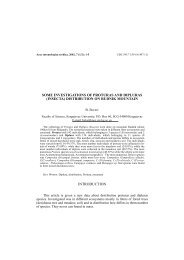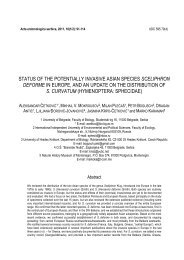NEW RESULTS ON DIPTERA PREDATORS IN THE BLACKFLY ...
NEW RESULTS ON DIPTERA PREDATORS IN THE BLACKFLY ...
NEW RESULTS ON DIPTERA PREDATORS IN THE BLACKFLY ...
You also want an ePaper? Increase the reach of your titles
YUMPU automatically turns print PDFs into web optimized ePapers that Google loves.
136<br />
Empididae<br />
D. WERNER AND A. C. P<strong>ON</strong>T<br />
Fig. 2. Alliopsis spec. nov., females feeding on a larva of Prosimulium petrosum Rubtsov (Photo:<br />
WERNER 6/2005).<br />
The number of 29 species of Empididae that are active predators of blackflies has been substantially<br />
increased by our collections in 2005 and 2006. Some brief results are given here of studies<br />
on species that are associated with blackfly populations in Central Europe. All adult Empididae<br />
are predaceous, and in the huge genera Empis Linnaeus, Rhamphomyia Meigen, and Hilara<br />
Meigen, the male captures and presents a “wedding gift” to the female which consumes it during<br />
copulation.<br />
The two most abundant species during our investigations were Rhamphomyia crassirostris<br />
(Fallén, 1816) and Hilara maura (Fabricius, 1776). They were present at all localities and sometimes<br />
formed up to 98% of the individuals caught with simuliid prey. Because of this association<br />
with the mass occurrence of simuliid populations, we were once again able to clarify many details<br />
in their behavior and biology.<br />
Other species of Hilara were observed, about which no biological information was known.<br />
Females and males of these species swarm together in shaded habitats beneath alder bushes. It is<br />
known that the males of many species of Hilara gather debris off the water surface for their wedding<br />
gifts. At our study site in Germany, however, some Hilara species captured only live prey. In<br />
this case, the prey species was Simulium equinum (Linnaeus, 1758).<br />
Many species of Simuliidae also swarm and copulate beneath or alongside the river bank.<br />
Their favourite markers are willows. The males of Rhamphomyia crassirostris catch their prey<br />
while swarming under willow trees on the river bank and immediately present it to a female that is<br />
ready to mate. They only mate in flight, and do not settle on vegetation as do other Empididae. At<br />
some sites, Simuliidae formed 100% of the prey that we recorded, although Chironomidae, other<br />
Empididae, Muscidae, and also Ephemeroptera were swarming in the same habitat.










